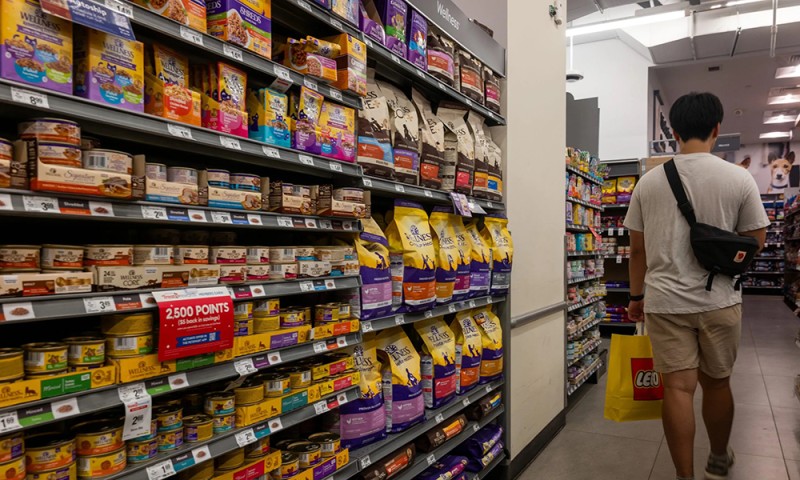
• 近期经济数据对关税影响物价的程度持续释放矛盾信号,导致华尔街对“究竟谁在买单”分歧巨大。目前企业可能在很大程度上承担了关税成本,但其承受能力还能维持多久,消费者未来又要分担多少,目前均无定论。
在唐纳德·特朗普发动贸易战数月之后,美国经济数据仍对于关税对物价的影响程度释放出矛盾信号。
尽管消费者价格指数(CPI)略有上升,但其涨幅始终低于预期;而最新生产者价格指数(PPI)却意外上行。
部分受关税冲击严重的行业出现价格飙升,但7月份的数据显示,部分商品价格上涨压力有所缓解,而某些服务领域承受的价格压力则有所增加。
摩根大通(JPMorgan)经济学家迈克尔·费罗利率领的团队在上周五的报告中指出:“尽管物价呈现坚挺态势,但迄今为止关税对消费价格的传导效应显然没有预期的那么糟糕。”
该行认为,通胀数据未显著抬升的潜在原因在于,企业正以牺牲利润率为代价自行消化关税成本。当前企业利润率处于历史高位,足以在不损害资本或运营预算的前提下吸纳新增成本。
摩根大通补充道,其他解释因素包括:企业消化关税前的库存延缓了关税对价格的影响、夏季通胀季节性弱于冬季的特征,以及关税成本更多通过服务而非商品的形式转嫁。
另一种可能是进口商实际支付的关税税率远低于公布的数字。巴克莱银行(Barclays)近期的报告显示,5月加权平均关税税率仅有9%,低于该行预估的12%。
原因在于需求从高关税国家向外转移,且当月超半数美国进口商品享受免税待遇。例如,虽然美国提高加拿大关税税率,但美墨加协定覆盖的商品不受影响。
报告指出:“美国经济韧性真正令人惊讶之处,并非其对关税的反应,而是在于实际关税税率涨幅远低于普遍预期。”
当然,巴克莱银行表示,当前加权平均税率已微升至10%,预计最终将稳定在15%左右,因药品等更多商品可能被征税,且税收漏洞也将逐步收紧。
企业与消费者
花旗研究(Citi Research)仍未发现关税引发广泛价格压力的明显证据,并将近期服务价格上涨归因于一次性异常因素,如资产价格反弹导致投资组合管理费骤增5.8%。
即便未来加征更多关税,花旗仍预计消费者不会遭遇大幅涨价。
首席美国经济学家安德鲁·霍伦霍斯特在报告中指出:“需求日益疲软意味着企业难以将关税成本转嫁给消费者。尽管一些企业可能会在未来数月尝试缓慢提价,但既往经验表明涨幅将极为有限。这应能缓解人们对通胀上行风险的担忧,同时加重对企业因利润率下降而缩减招聘的担忧。”
相比之下,高盛(Goldman Sachs)预测消费者将承担大部分关税成本。截至6月,消费者承担的关税成本比例为22%,但若特朗普前期贸易行动模式延续,该比例将在10月飙升至67%。
对于企业而言,负担的比例将从64%降至8%,而外国供应商承担的关税影响将从14%上升至25%。
解开“关税对通胀的影响程度”这个谜题,对美联储(Federal Reserve)而言至关重要。该机构正竭力平衡其双重使命。
关税导致通胀持续高于美联储2%的目标水平,迫使政策制定者暂缓降息。但就业数据疲软已拉响警报,强化了放宽货币政策的呼声。
花旗的霍伦霍斯特写道:“迄今为止的证据表明,关税带来的成本几乎都由本土企业承担。成本传导的缺失应能缓解美联储官员一直以来对通胀的担忧,为9月启动连续降息铺平道路。如果说有什么问题,那就是市场低估了未来更快/更大幅度降息的可能性。”(*)
译者:刘进龙
审校:汪皓
• 近期经济数据对关税影响物价的程度持续释放矛盾信号,导致华尔街对“究竟谁在买单”分歧巨大。目前企业可能在很大程度上承担了关税成本,但其承受能力还能维持多久,消费者未来又要分担多少,目前均无定论。
在唐纳德·特朗普发动贸易战数月之后,美国经济数据仍对于关税对物价的影响程度释放出矛盾信号。
尽管消费者价格指数(CPI)略有上升,但其涨幅始终低于预期;而最新生产者价格指数(PPI)却意外上行。
部分受关税冲击严重的行业出现价格飙升,但7月份的数据显示,部分商品价格上涨压力有所缓解,而某些服务领域承受的价格压力则有所增加。
摩根大通(JPMorgan)经济学家迈克尔·费罗利率领的团队在上周五的报告中指出:“尽管物价呈现坚挺态势,但迄今为止关税对消费价格的传导效应显然没有预期的那么糟糕。”
该行认为,通胀数据未显著抬升的潜在原因在于,企业正以牺牲利润率为代价自行消化关税成本。当前企业利润率处于历史高位,足以在不损害资本或运营预算的前提下吸纳新增成本。
摩根大通补充道,其他解释因素包括:企业消化关税前的库存延缓了关税对价格的影响、夏季通胀季节性弱于冬季的特征,以及关税成本更多通过服务而非商品的形式转嫁。
另一种可能是进口商实际支付的关税税率远低于公布的数字。巴克莱银行(Barclays)近期的报告显示,5月加权平均关税税率仅有9%,低于该行预估的12%。
原因在于需求从高关税国家向外转移,且当月超半数美国进口商品享受免税待遇。例如,虽然美国提高加拿大关税税率,但美墨加协定覆盖的商品不受影响。
报告指出:“美国经济韧性真正令人惊讶之处,并非其对关税的反应,而是在于实际关税税率涨幅远低于普遍预期。”
当然,巴克莱银行表示,当前加权平均税率已微升至10%,预计最终将稳定在15%左右,因药品等更多商品可能被征税,且税收漏洞也将逐步收紧。
企业与消费者
花旗研究(Citi Research)仍未发现关税引发广泛价格压力的明显证据,并将近期服务价格上涨归因于一次性异常因素,如资产价格反弹导致投资组合管理费骤增5.8%。
即便未来加征更多关税,花旗仍预计消费者不会遭遇大幅涨价。
首席美国经济学家安德鲁·霍伦霍斯特在报告中指出:“需求日益疲软意味着企业难以将关税成本转嫁给消费者。尽管一些企业可能会在未来数月尝试缓慢提价,但既往经验表明涨幅将极为有限。这应能缓解人们对通胀上行风险的担忧,同时加重对企业因利润率下降而缩减招聘的担忧。”
相比之下,高盛(Goldman Sachs)预测消费者将承担大部分关税成本。截至6月,消费者承担的关税成本比例为22%,但若特朗普前期贸易行动模式延续,该比例将在10月飙升至67%。
对于企业而言,负担的比例将从64%降至8%,而外国供应商承担的关税影响将从14%上升至25%。
解开“关税对通胀的影响程度”这个谜题,对美联储(Federal Reserve)而言至关重要。该机构正竭力平衡其双重使命。
关税导致通胀持续高于美联储2%的目标水平,迫使政策制定者暂缓降息。但就业数据疲软已拉响警报,强化了放宽货币政策的呼声。
花旗的霍伦霍斯特写道:“迄今为止的证据表明,关税带来的成本几乎都由本土企业承担。成本传导的缺失应能缓解美联储官员一直以来对通胀的担忧,为9月启动连续降息铺平道路。如果说有什么问题,那就是市场低估了未来更快/更大幅度降息的可能性。”(*)
译者:刘进龙
审校:汪皓
• Recent economic data continue to give mixed signals on how much tariffs are affecting prices, leaving Wall Street conflicted on who is paying for what. While companies may be absorbing much of the tariff costs for now, it’s not clear how much longer they can keep it up and how much consumers will be able to shoulder later.
Months after President Donald Trump launched his trade war, economic data continue to give mixed signals on how much tariffs are affecting prices in the U.S.
While the consumer price index has ticked higher, it has also consistently come in below forecasts, though the latest reading on producer prices surprised to the upside.
Certain sectors heavily exposed to tariffs have seen spikes, but July data showed less upward price pressure on some goods prices and more pressure on some services.
“Despite this firmness, the tariff pass-through effect on consumer prices arguably has been less bad than expected so far,” JPMorgan economists led by Michael Feroli said in a note on Friday.
According to the bank, one potential explanation for the muted inflation numbers is that firms are eating the tariff cost at the expense of their profit margins, which are currently wide by historical standards and can accommodate the added costs without harming capital or operating budgets.
Other explanations include the delayed effects of duties on prices as companies draw down pre-tariff inventories, the seasonality of prices as inflation during the summer tends to be softer than in the winter, and tariff costs being passed though more via services rather than goods, JPMorgan added.
Yet another explanation could be that the tariff rates importers are actually paying are far below the headline numbers. A recent Barclays report found that the weighted-average levy in May was just 9% versus the bank’s estimate for 12%.
That’s because demand shifted away from countries with higher tariffs while more than half of U.S. imports that month were duty-free. Despite higher rates on Canada, for example, they don’t apply to goods covered under the U.S.-Mexico-Canada trade agreement.
“The real surprise in the U.S. economy’s resilience lies not in its reaction to tariffs but that the rise in the effective tariff rate has been more modest than commonly thought,” the report said.
To be sure, Barclays said the weighted-average rate has edged up to 10% today and predicted it will eventually settle at around 15%, as more products like pharmaceuticals are expected to get hit with levies and as loopholes close.
Businesses vs. consumers
Citi Research still doesn’t see much evidence of broad-based price pressure from tariffs and attributed the recent uptick in services to one-time anomalies, such as the 5.8% jump in portfolio management fees due to the rally in asset prices.
Citi also doesn’t expect consumers to get hit with big price hikes in the future, even as more levies are expected to roll out.
“Softer demand means firms will have difficulty passing tariff costs on to consumers,” chief US economist Andrew Hollenhorst said in a note. “While some firms might still attempt to slowly increase prices in coming months, the experience so far suggests these increases will be modest in size. This should reduce concerns about upside risk to inflation and increase concerns that decreased profit margins will cause firms to pullback on hiring.”
By contrast, Goldman Sachs predicted consumers will pay most of the tariff costs. As of June, they had absorbed 22%, but that figure should jump to 67% by October if the pattern seen in early rounds of Trump’s trade actions continues.
For businesses, the burden will shrink from 64% down to 8%, while foreign suppliers will see an uptick from 14% to 25% of the tariff impact.
Unraveling the mystery over what tariffs are doing—or not doing—to inflation has major implications for the Federal Reserve, which is trying to balance both sides of its dual mandate.
Tariffs have kept inflation stubbornly above the Fed’s 2% target, causing policymakers to hold off on rate cuts. But weakness in jobs data have raised alarms on employment, fueling demands for easing.
“The evidence so far is that almost all of the costs of tariffs are being born by domestic firms,” Citi’s Hollenhorst wrote. “The lack of pass-through should reduce lingering Fed official inflation concerns and allow for a series of rate cuts beginning in September. If anything markets are underpricing the potential for faster and/or deeper cuts.”

